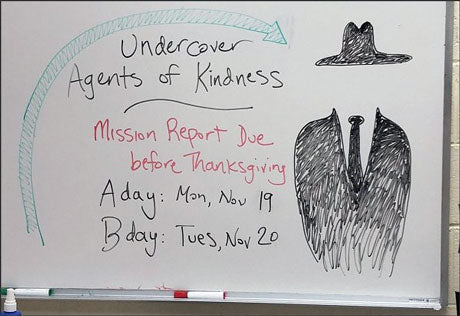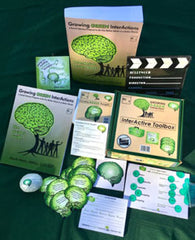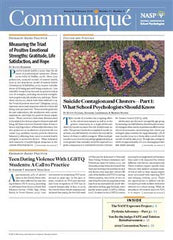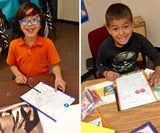Menu
-
- Home
-
About Us
-
The Approach
-
Linking Language & Literacy
-
MindWing Learning
-
Learning Resources
-
SHOP
-
Blog
-
- About MindWing
- Our People
- Contact Us
- Your Account
- Login
-
Spain (EUR €)

Teaching “Kindness” and Other “Feelings”
March 07, 2019 3 min read
January 14, 2019
 When viewing the emails on my computer today, I came across an article from Education Week Teacher entitled “Want Your Children to be Kinder? Try This Assignment” by Justin Parmenter. The author encouraged his students to be “Undercover Agents of Kindness” as they each drew the name of a classmate and planned to perform a mission of kindness: “an unexpected act of kindness for the classmate.” After doing the unexpected act of kindness, the students were asked to write a “mission report,” “detailing what they did and how it went.”
When viewing the emails on my computer today, I came across an article from Education Week Teacher entitled “Want Your Children to be Kinder? Try This Assignment” by Justin Parmenter. The author encouraged his students to be “Undercover Agents of Kindness” as they each drew the name of a classmate and planned to perform a mission of kindness: “an unexpected act of kindness for the classmate.” After doing the unexpected act of kindness, the students were asked to write a “mission report,” “detailing what they did and how it went.”
What was interesting in the article was that many of the students did not normally talk with each other, and when they drew a name had no idea who the student was, although the seventh grade language arts class was in operation for two months at the time of the assignment!
 I thought of the Story Grammar Marker® when I read this piece and how great would it be to use the SGM® Episode Organizer to write about the mission via the feelings, thoughts, plans, attempts and consequences, as well as lessons learned by both the doer and the receiver.
I thought of the Story Grammar Marker® when I read this piece and how great would it be to use the SGM® Episode Organizer to write about the mission via the feelings, thoughts, plans, attempts and consequences, as well as lessons learned by both the doer and the receiver.
In keeping with the above email, I have been reflecting on a program a fellow speech/language pathologist Herb Hein introduced me to at ASHA, 2018, in Boston. It is called Growing Green Interactions Social Literacy Program. As I listened to him speak I began thinking about the need to develop and nurture the “Five Green Character Traits’ fostered through the program. They are:
- Grateful, to appreciate
- Respectful, to be well mannered
- Empathetic, to care about feelings of others (kindness)
- Easygoing, to cooperate
- Navigating, to use strategies to cope with challenges
 Each of these traits create social interaction skills and enable students to work in groups to solve problems, particularly those occurring in their lives or the lives of those around them. The manuals accompanying the program delineate well-constructed targets for guiding students as they, themselves, build these traits over time.
Each of these traits create social interaction skills and enable students to work in groups to solve problems, particularly those occurring in their lives or the lives of those around them. The manuals accompanying the program delineate well-constructed targets for guiding students as they, themselves, build these traits over time.
I loved the musical materials. Seventeen short songs focusing on optimism (Optimism Returns), gratitude (Grateful), life appreciation (I Appreciate) and hope (Forward Dreams). The Interactive Toolbox contains reinforcers for use as students work to acquire the characteristics. The components of the program lend themselves to collaboration among specialists and teachers alike.
 In accordance with the last sentence above, the January/February 2019 issue of Communique, a publication of the National Association of School Psychologists, features an article entitled “Measuring the Triad of Positive Emotional Strengths: Gratitude, Life Satisfaction and Hope” by Scott Huebner (an account is needed to read). The article calls for attention to positive indicators of strengths, including emotional strengths such as gratitude, life satisfaction and hope. Citations (Seligman, 2002) called these three constructs the “triad of positive emotions.” These constructs were cited in the following reference:
In accordance with the last sentence above, the January/February 2019 issue of Communique, a publication of the National Association of School Psychologists, features an article entitled “Measuring the Triad of Positive Emotional Strengths: Gratitude, Life Satisfaction and Hope” by Scott Huebner (an account is needed to read). The article calls for attention to positive indicators of strengths, including emotional strengths such as gratitude, life satisfaction and hope. Citations (Seligman, 2002) called these three constructs the “triad of positive emotions.” These constructs were cited in the following reference:
M. J. Furlong, R. Gilman & E. S. Huebner (Eds). Handbook of positive psychology in schools (2nd edition) New York, NY: Routledge.
It seems that Growing G.R.E.E.N. Interations Social Literacy Program would be a perfect fit when planning programs to assist students to grow interative skills which incorporate the “triad of positive emotions.”
 It also brought to mind a great paper entitled Mirrors, Windows and Sliding Glass Doors (PDF link) by R.S. Bishop. This book is about choosing books and “missions” that allow students to see themselves (as in a mirror), others’ actions (as through a window) and sliding-glass doors (actually cooperatively experiencing something with another). This shared experience may be through quality children’s literature.
It also brought to mind a great paper entitled Mirrors, Windows and Sliding Glass Doors (PDF link) by R.S. Bishop. This book is about choosing books and “missions” that allow students to see themselves (as in a mirror), others’ actions (as through a window) and sliding-glass doors (actually cooperatively experiencing something with another). This shared experience may be through quality children’s literature.
 And, as I was thinking about this book, I received my Reading Teacher Journal. I opened to a bibliography on page 513 citing Bishop’s book in the References! The article is by Ruth Culham. It is entitled “Reading with a Writer’s Eye: Why Book Choice Matters.” The following quote is from this article:
And, as I was thinking about this book, I received my Reading Teacher Journal. I opened to a bibliography on page 513 citing Bishop’s book in the References! The article is by Ruth Culham. It is entitled “Reading with a Writer’s Eye: Why Book Choice Matters.” The following quote is from this article:
“Books not only provide a mirror of our own experiences but also offer a window into others’ lives. Students who could never imagine everyday life outside their own zip codes get to know characters in fiction and subjects in non-fiction whose languages and lives may be not at all the same as theirs.
“Barriers to new relationships and understandings can be breached with classrooms full of texts that celebrate and honor ways of living and loving different from students’ own.”
As often happens, my days begin with associations between research and the Story Grammar Marker®’s narrative mode of thought that enables perspective-taking looking at mirrors, through widows and maybe walking through that sliding glass door! Justin Parmenter’s mission is well thought out since kindness shows caring for others. — MRM
Leave a comment.
Comments will be approved before showing up.
